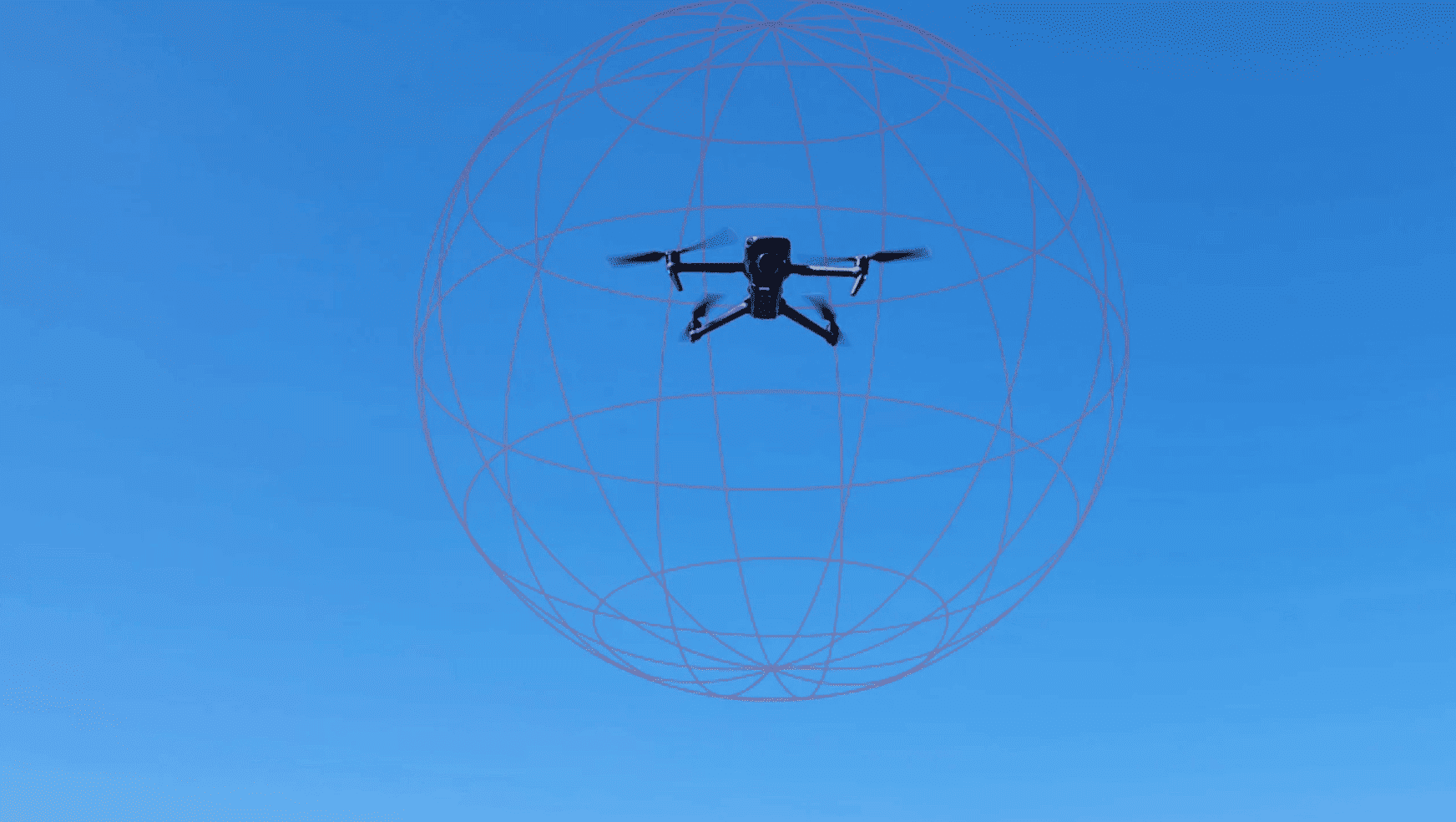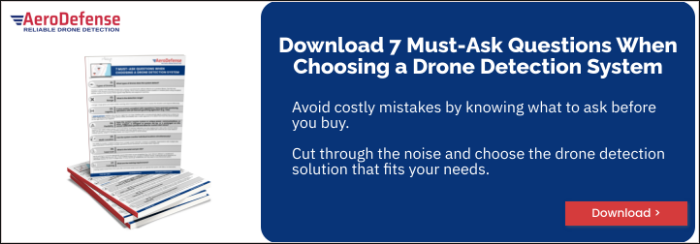Summary: What drone Remote ID is and how it is evolving the drone-detection ecosystem.
Learn when it takes effect, the types of Remote ID, what information is broadcast, who can receive it, and how it fits with more advanced drone detection solutions (including AeroDefense’s own systems).
In this Quick Guide to drone Remote ID, we’ll get you up to speed on what drone Remote ID is and how drone Remote ID is changing the drone detection game.
What is Drone Remote ID?
To enhance airspace security, the Federal Aviation Administration (FAA) mandated drone Remote Identification (ID), which requires all drones in flight to provide identification and location information that can be received by other parties.
Drone Remote ID is essentially a drone license plate, but the drone’s owner may not be directly listed in the information broadcast. To protect the privacy of the drone operator, either a serial number or a session ID is broadcast.
Authorized individuals from public safety organizations can contact the FAA to get the pilot’s information. At the time this article was published, there was no additional information on the process. We recommend you contact your LEAP agent or an FAA Regional Operations Center for more information.
| Facility | States | Phone Number | |
|---|---|---|---|
| Western ROC | AK, AZ, CA, CO, HI, ID, MT, NV, OR, UT, WA, WY | 206-231-2089 | 9-WAS-OPSCTR@FAA.GOV |
| Central ROC | AR, IA, IL, KS, LA, MI, MN, MO, ND, NE, NM, OH, OK, SD, TX, WI | 817-222-5006 | 9-CSA-ROC@FAA.GOV |
| East ROC | AL, CT, FL, GA, KY, MA, ME, MS, NC, NH, PR, RI, SC, TN, VI, VT | 404-305-5180 | 9-ESA-ROC@FAA.GOV |
| East ROC | DC, DE, MD, NJ, NY, PA, VA, WV | 404-305-5150 | 9-ESA-ROC@FAA.GOV |
When Does Drone Remote ID Take Effect?
Drones manufactured after December 16, 2022 must include drone Remote ID capability.
Existing drones must be compliant either through updates or broadcast modules by September 16, 2023.
Any drones under 250 grams do not currently need to comply with drone Remote ID requirements.
What Are the Types of Drone Remote ID?
Standard Drone Remote ID
Standard drone Remote ID is when the capability is built into the drone by the manufacturer.
Broadcast Drone Remote ID
Broadcast is a drone that has an external broadcast module equipped to be drone Remote ID compliant. For example, this could be an older drone that cannot simply receive a software update to become compliant.
There are operating limitations when using this style of drone Remote ID when compared to the standard. Those limitations surround Operations Over People (OOP) and beyond visual line of sight (BVLOS). Broadcast drones are not allowed to operate Beyond Visual Line Of Sight, whereas standard drone Remote ID can apply for a waiver for BVLOS operations. Drones with broadcast modules can only meet some aspects of the OOP categories; therefore they are limited in their ability for operations over people.
FRIA
FAA Recognized Identification Areas (FRIA) are the only legal locations to operate drones without drone Remote id broadcasting elements.
An example of this would be a local field that is designated for radio-controlled flight. These are in low risk areas and a known spot where planes and drones are operated. The FAA estimates that there will be 4000 FRIAs across the US.
What Information is Broadcast with Drone Remote ID?
Standard drone Remote ID broadcasts the Drone ID, Location, Altitude, Velocity, Control station Location and elevation, Time Mark, and Emergency Status.
Drones with a drone Remote ID Broadcast Module broadcast Drone ID, Location, Altitude, Velocity, Takeoff Location and Elevation, and Time Mark.
The primary difference between the standard drone Remote ID and the broadcast drone Remote ID is the controller location. Standard drone Remote ID dynamically updates the location of the Ground Control Station (GCS) during the flight, whereas a broadcast module will only broadcast the location from which the drone took off. While this is usually the location of the controller, it will be different if the pilot moves while operating the drone.
Drone ID is a unique identifier for the drone. Standard drone Remote ID drones may choose whether to use the drone’s serial number or a session ID while Broadcast modules broadcast the module’s serial number. The drone’s serial number can be used to identify the make and model of the drone through the FAA Declaration of Compliance list.
Currently, the FAA says, “The session ID will be uniquely identifiable such that law enforcement and the FAA can correlate each session ID to a specific drone’s serial number, but this ability will not be publicly available. The FAA is developing a strategy for the assignment of session IDs to drone pilots and will consider existing policies when developing the session ID policy. In addition, the FAA will seek public comment on the session ID policy prior to finalizing it.”
Who Can Receive Drone Remote ID Broadcasts?
Drone Remote ID broadcasts are publicly accessible, meaning anyone with a compatible receiver or mobile app can view them. While mobile apps offer convenience, their range is typically much more limited compared to dedicated receivers.
Looking up drone IDs and session IDs to identify the name of the pilot must be done by a “person of authority” and by contacting the FAA. What Drones & Devices are Currently Capable of Transmitting on drone Remote ID?
The list of drones and modules that are in compliance with the FAA drone Remote ID requirements can be found here. As new drones are manufactured, they are added to the list.
Some drones currently on that list are DJI Mavic 3 series, DJI Avita, DJI Agras T30 & T40, Autel Dragonfish Series, Autel Evo II series, Parrot Anifi AI.
Some Broadcast modules are Drone Tag, Bluemark DB200 and others. These modules can be integrated with drones to make older drones compliant with drone Remote ID.
Is Drone Remote ID a Replacement for More Advanced RF Drone Detection?
With drone Remote ID now in effect, a majority of drone-related issues are expected to stem from pilots who are broadcasting a drone Remote ID signal. This makes drone Remote ID and drone detection a highly effective solution for organizations. By identifying and tracking these drones, organizations can quickly address potential security risks and enforce compliance.
Any organization that is seeing drones overhead not broadcasting drone Remote ID might have a deeper issue and require more advanced systems.
How Does Drone Remote ID Change AeroDefense’s AirWarden® System?
All AirWarden systems receive drone Remote ID broadcasts.
AeroDefense offers drone detection solutions that not only receive drone Remote ID broadcasts but also detect drones not broadcasting a drone Remote ID signal.
Drone Remote ID FAQs
What is Remote ID and why is it important?
Remote ID requires drones (in the U.S. those over 0.55 lb/250 g or used commercially) to broadcast information such as the drone’s ID, location, altitude, and pilot or take-off location. This enhances accountability, helps security/airspace monitoring, and enables detection systems to identify and locate drones and potentially their operators.
How are drones required to comply with Remote ID?
There are generally three compliance paths:
-
- Standard Remote ID: Built-into the drone by the manufacturer and transmits live location of control station.
- Broadcast Module: An add-on module for older drones which may broadcast only take-off location rather than live pilot location.
- FAA-Recognized Identification Area (FRIA): Designated zones where drones may fly without broadcasting Remote ID under certain conditions.
How is Remote ID detected or used by organizations?
Organizations can use:
-
- Mobile apps: These may work for hobbyist use but have limitations in range, reliability and 24/7 monitoring. (AeroDefense)
- Dedicated Remote ID receivers: Purpose-built hardware with strong antennas and continuous monitoring are far more reliable for security/critical-asset use.
Is Remote ID alone enough for all drone detection/security scenarios?
For many everyday use-cases, yes: it provides practical drone awareness and pilot traceability for the “vast majority” of compliant drones. (AeroDefense)
But no: in higher-risk scenarios (non-compliant drones, modified drones, stealth operations), other detection technologies (RF direction-finding, radar, EO/IR) are still needed.
Can Remote ID be easily bypassed or disabled by malicious operators?
While bypassing Remote ID is sometimes claimed, in practice it is far more complex, technically demanding and risky than often portrayed. (AeroDefense)
What are the benefits of integrating Remote ID into a drone-detection/security program?
- Enables real-time identification of drone flights with key metadata (ID, location, altitude).
- Provides a cost-effective baseline layer of airspace awareness.
- Helps focus response efforts: non-broadcasting drones become higher priority for further investigation or layered detection.

